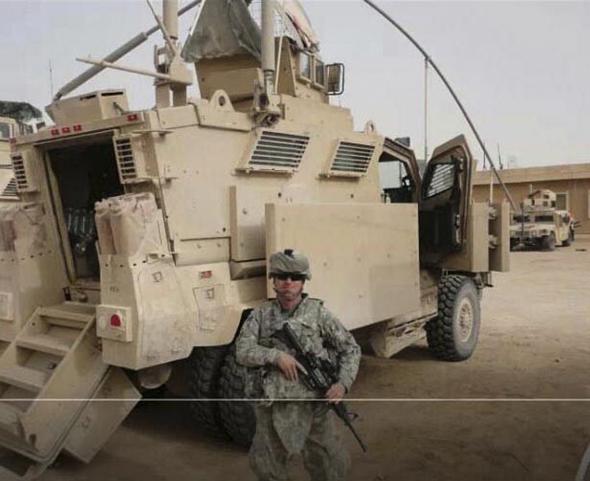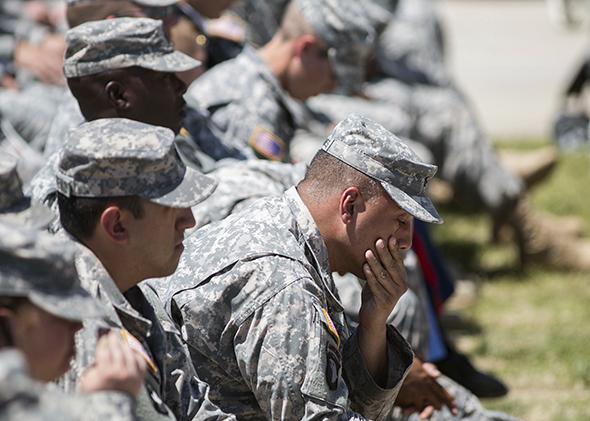In September 2007, at the height of the Iraq surge, I spent two weeks with the Army’s 2nd Battalion, 12th Infantry in Dora, one of the deadliest neighborhoods in Baghdad. By that point in the war, I had embedded with a dozen-odd infantry units, and 2-12, the “Lethal Warriors” from Fort Carson in Colorado, was one of the best I’d seen. Cocky, aggressive, and competent in all the right ways, they exuded an indifference toward death that was hard not to admire. The dangers they lived with for months are impossible to describe with any justice, but one image stays with me, the thing I saw the first time I walked into 2-12’s command post. On the wall in front of me were 16 framed photographs, one for each soldier killed in-country.
At the end of their 15-month tour in Iraq, the Lethal Warriors returned to Fort Carson with an impressive battlefield record, having cleared one of the worst parts of Baghdad, in some cases digging up IEDs with little more than screwdrivers and tire irons. Unfortunately, the Lethal Warriors achieved a kind of notoriety that was less for their battlefield exploits than for the battalion’s connection to a string of murders. In December 2007 two soldiers from the unit, Robert James and Kevin Shields, were killed, and three fellow soldiers were charged with murder. The killings were part of a larger pattern of violence extending back to 2005, including 11 murders, in what was the largest killing spree involving a single army base in modern U.S. history.
The increased violence around Fort Carson began at the start of the Iraq war. A 126-page Army report known as an “Epidemiological Consultation” released in 2009 found that the murder rate around the Army’s third-largest post had doubled and that the number of rape arrests had tripled. As David Philipps wrote in Lethal Warriors, his 2010 book about the crime spree, “In the year after the battalion returned from Iraq, the per-capita murder rate for this small group of soldiers was a hundred times greater than the national average.” Tellingly, 2-12’s post-traumatic stress disorder rate was more than three times that of an equivalent unit that had served in a less violent part of Iraq. The EPICON summarized all this in classic bureaucratic language, noting dully that there was “a possible association between increasing levels of combat exposure and risk for negative behavioral outcomes.”
Put another way, war has a way of bringing out the dark side in people.
The idea that PTSD is unrelated to violence back home is one of the central pillars of today’s rigid “support the troops” campaign. After every mass shooting event involving a veteran, Veterans Affairs psychiatrists and veterans advocates deliver the same stern warning: Mentioning PTSD in conjunction with these shootings is not only inaccurate, it hurts veterans. The Iraq and Afghanistan Veterans of America’s press release earlier this month after the second Fort Hood shooting is representative: “In moments like this, there is a tendency by some to paint a broad brush across the entire veterans community and it’s important to guard against this mistake. We encourage everyone—especially those in the media and political positions—to be thoughtful and responsible in their reactions and to remember that correlation does not imply causation.”
We are insistently told that it is irresponsible to even consider what deeper, more complex forces might be at work in these military base shootings. Veterans are heroes, murderers are deranged individuals; there is no connection between war service and homicide at home, full stop.
While it is inaccurate to say that PTSD causes violence, the unfortunate truth is that there is a link between PTSD and postwar homicide, and it’s far more than just a passing correlation. Serving in a war zone exposes people to very serious moral challenges, and the experience can serve as a catalyst, making some people less stable and more violent than they might have been otherwise. War is hell, and the hell rubs off.
Consider the following: A 2010 study funded by the Marine Corps and conducted by the Naval Health Research Center in San Diego surveyed 1,543 Marines with at least one combat tour and found that Marines who had reported PTSD symptoms were more than six times as likely to engage in antisocial and aggressive behaviors than those who did not report PTSD symptoms. A similar study published in 1984 in the Archives of General Psychiatry found a “significant association between combat exposure and subsequent arrests and convictions that persisted when preservice background factors were controlled.”
This pattern of veterans returning profoundly altered and in some cases more violent is not a new phenomenon. History is replete with examples of wars that came home. In Shook Over Hell: Post-Traumatic Stress, Vietnam, and the Civil War, historian Eric T. Dean Jr. notes that the years following the Civil War were marked by unprecedented levels of violence and criminality in the United States. In the victorious North, fully two-thirds of all men sentenced to prison were veterans. In some states the prison population increased by 400 percent. In 1866 a reporter for the New York Times went so far as to declare that the crime wave was the fault of the “rough material turned loose upon society by the close of the war.” Other historians, such as Drew Gilpin Faust, have pointed to the pervasive violence of the American West as being at least partially a result of the moral anarchy and rootlessness created by the Civil War.
This violence isn’t limited to veteran-on-veteran or veteran-on-civilian crimes either. As Dane Archer, a University of California–Santa Cruz sociologist, noted in a 1976 study in the American Sociological Review, wars are closely associated with elevated crime rates across the entire population: “During the Vietnam War, the murder and nonnegligent manslaughter rate in the United States more than doubled.” At the conclusion of the study, Archer argued that “[w]ars provide concrete evidence that homicide, under some conditions, is acceptable in the eyes of the nation’s leaders. This wartime reversal of the customary peacetime prohibition against killing may somehow influence the threshold for using homicide as a means of settling conflict in everyday life.”

Photo handout via Reuters
It’s a long way from invading a foreign country to stateside violence years later, but when you start looking at the individual cases of military veteran killers, a pattern begins to emerge: A rambunctious young man who never excelled in school joins the military; at first he loves the structure but eventually he begins to have trouble with his superiors. In time he goes off to war and is exposed to intense levels of violence. When he returns to the United States, he develops a substance abuse habit, partly to keep the horrific images of war at bay. This leads to a series of violent incidents and financial problems that seem trivial at first, then progressively worsen. Finally, high and/or drunk and unable to control his impulses, he ends up in an altercation with another soldier and ends up killing in what appears at first to be a random act of violence.
This is roughly what happened with the Lethal Warrior killings. After I returned from Iraq and began working on a book on the history of PTSD, I kept in touch with two platoon commanders from 2-12, including John Feeney, a West Point graduate who had two of the murderers in his platoon. Feeney declined to be interviewed for Philipps’ book and was never contacted for a later Rolling Stone article, but when I asked him about it he emailed me, saying, “Much of it is true, and horrid, but they [Philipps and Rolling Stone reporter L. Christopher Smith] take the easy road against the big bad military by portraying some as model soldiers that never were.” Feeney, who left the Army in 2011, has a point here: One of the murderers, Bruce Bastien, had been arrested in 2007 for assaulting his wife while on leave from Iraq and was never sent back. The other killer in Feeney’s platoon, Kenneth Eastridge, had a long record of substance abuse and insubordination and had been court-martialed and sent home from Iraq midtour. Both Bastien and Eastridge had complained of PTSD symptoms before the murders.
It is impossible to say for sure what drove these young men to commit murder, but the idea that combat exposure and post-traumatic stress could be contributing factors makes sense if you look at war for what it is at the grunt level: murder that has been sanctioned by the government. The simple fact is that war poisons some men’s souls, and we aren’t doing our veterans any favors by pretending that war is only about honor and service and sacrifice and by insisting that PTSD is completely unrelated to the problem of postwar violence. It’s not only morally irresponsible, it’s scientifically inaccurate.
To be perfectly honest, I don’t want this to be true. In fact, as a veteran who has struggled with post-traumatic stress, I hate that it’s true, but war is an evil thing. As a society we need to face the reality of it head-on so that we can avoid the next war. And despite its official protests to the contrary, the VA secretly agrees with me. Visit any VA hospital across the country and you’ll see what I mean. What’s the first thing you see when you walk in? A metal detector with an armed VA police officer standing nearby.
